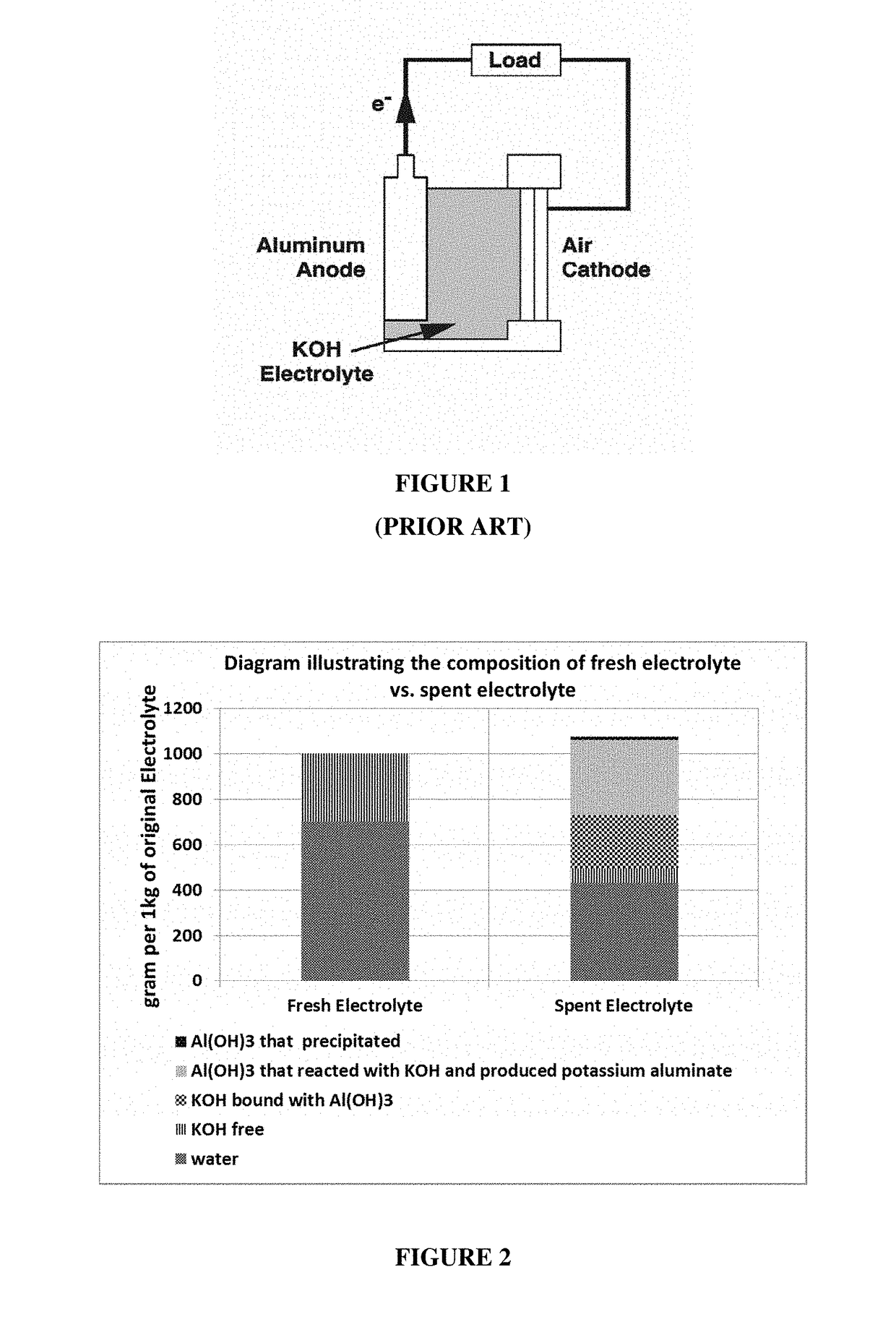Electrolyte regeneration
a technology of electrolyte and electrolyte, which is applied in the field of electrolysis-based process, can solve the problems of difficult separation from the used electrolyte solution, low efficiency of metal-air batteries, and difficulty in electrolyte regeneration, and achieve the effect of increasing reducing the concentration of alkali hydroxid
- Summary
- Abstract
- Description
- Claims
- Application Information
AI Technical Summary
Benefits of technology
Problems solved by technology
Method used
Image
Examples
example 1
Electrolysis of Spent Electrolyte-Materials and Methods
[0183]The experimental set-up used in the following examples consists of a cell as shown in FIG. 3, with nickel (Ni) plate serving as an anode (2) and an air electrode based on silver catalyst, as described below, serving as the cathode (4). A commercially available membrane type Neosepta CMX was used as the cation permeable membrane (3). The active area of the membrane was 9.6 square centimeter. The active area of the cathode was also 9.6 square centimeter. The anode electrode area was 24 square centimeter. The dimensions of the anodic and cathodic compartments were approximately 6*3*8 cm3. The electrodes were connected to the opposite poles of DC power source (i.e., the positive pole to the anolyte compartment and the negative pole to the catholyte compartment). Current densities are calculated based on cathode area.
[0184]The source of the K[Al(OH)4] samples employed as anolyte solutions in the set of experiments described bel...
example 2
Recovering Potassium Hydroxide from Aqueous Solution of K[Al(OH)4]
[0189]K[Al(OH)4] solution (115 cc, 0.2 Ah / cc) was introduced into the anode compartment of a membrane electrolysis cell. The solution used was the clear supernatant obtained as described above in example 1. Potassium hydroxide solution at a concentration of 10.4% w / w (110 cc) was introduced into the cathode compartment.
[0190]Current was applied between the electrodes, and the experiment was run for 21.6 hours. A constant current density of 100 mA / cm2 was applied throughout most of the experiment, with the exception of the time interval between 4.6 h to 6.02 h, during which the current density was reduced to 50 mA / cm2. The current flow capacity was 19.9 Ah and the energy put into the cell was 61.6 Wh. The experiment was allowed to run without any temperature control, and during the passage of the current through the cell, the temperature was around 31° C. due to self-heating.
[0191]No indication for hydrogen evolution w...
example 3
Recovering Potassium Hydroxide from Aqueous Solution of K[Al(OH)4]
[0195]K[Al(OH)4] solution (100 cc, 0.2 Ah / cc) was introduced into the anode compartment of a membrane electrolysis cell. The K[Al(OH)4] solution was a spent electrolyte removed from an aluminum / air battery and was used as is, with no treatment. Potassium hydroxide solution at a concentration of 10.4% w / w was (110 cc) was introduced to the cathode compartment.
[0196]Current was applied between the electrodes with current density of 100 mA / cm2. The experiment was run for 18.5 hours. The current flow capacity was 17.71 Ah. The experiment was allowed to run without any temperature control, and during passage of current through the cell, the temperature was around 32° C. due to self-heating.
[0197]No indication for hydrogen evolution was observed at the cathode side. The concentration in the catholyte compartment of the KOH solution increased from 10.4% w / w to 24.0% w / w. The volume of the catholyte was increased by about 22 ...
PUM
| Property | Measurement | Unit |
|---|---|---|
| temperature | aaaaa | aaaaa |
| current density | aaaaa | aaaaa |
| time | aaaaa | aaaaa |
Abstract
Description
Claims
Application Information
 Login to View More
Login to View More - R&D
- Intellectual Property
- Life Sciences
- Materials
- Tech Scout
- Unparalleled Data Quality
- Higher Quality Content
- 60% Fewer Hallucinations
Browse by: Latest US Patents, China's latest patents, Technical Efficacy Thesaurus, Application Domain, Technology Topic, Popular Technical Reports.
© 2025 PatSnap. All rights reserved.Legal|Privacy policy|Modern Slavery Act Transparency Statement|Sitemap|About US| Contact US: help@patsnap.com



